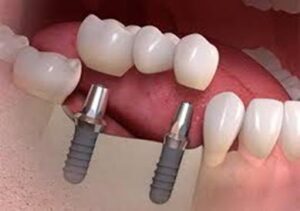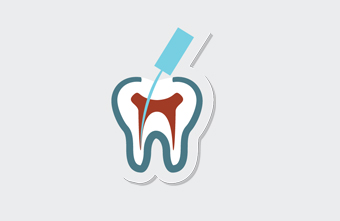
What are Dental Implants?
A dental implant is used to support one or more false teeth. It is a titanium screw that can replace the root of a tooth when it fails. Just like a tooth root, it is placed into the jawbone.
Why Would You Need a Dental Implant?
A dental surgeon examines the area to be considered for the dental implant and makes a clinical assessment of whether the patient is a good candidate for a dental implant.
There are great advantages to choosing a dental implant for tooth replacement over the other options. Dental implants are conservative in that missing teeth can be replaced without affecting or altering the adjacent teeth. Furthermore, because dental implants integrate into the bone structure, they are very stable and can have the look and feel of one’s own natural teeth.
Dental implants can be used to replace a single missing tooth

Single Missing Teeth

Multiple Missing Teeth
For patients who have lost all their teeth due to decay or gum disease of the upper and/or lower arch, an option is available to provide a very stable and comfortable prosthesis using a minimal number of implants by “All-On-4” technique. The All-On-4 technique provides teeth replacement that is stable (not removable) and feels like natural teeth compared to the older method of traditional (removable) complete dentures.
What Happens Before, During, and After Dental Implant Surgery?
During the consult and planning stage, the dental surgeon will visually examine the site in the mouth where a dental implant is being considered as well as look at dental imaging studies (X-rays, panoramic films, and/or CT scans). At this time, the quality and quantity of jawbone is assessed to determine if more bone is needed at the site. Once it has been established that a dental implant can be placed in the desired location, the patient will return for surgical procedures for the dental implant(s). During all surgical procedure appointments, the patient is usually given local anesthetic to numb the surgical area as well as any other sedatives necessary for comfort and anxiety.
The first stage of oral surgery often involves a tooth or teeth extraction. Oftentimes, the site of a dental implant still has an existing damaged tooth present. In order to prepare for placement of a dental implant, the tooth will need to be extracted. More often than not, an “alveolar bone graft” (cadaver or synthetic bone) is placed to achieve a solid base of bone for the implant. This site will be allowed to heal for two to six months. For a site that has no tooth and bone loss is present, it will require a different bone graft that is placed on top of existing jawbone (“onlay bone graft”). This procedure is more involved and usually requires about six or more months of healing. In some instances, when enough bone is present, the damaged tooth can be extracted followed by the implant placement procedure at the same appointment. This procedure is called “immediate implant” placement.
In the situation where an implant is to be placed in the maxilla (upper jaw) in the back or posterior region, sometimes the available amount of bone may be limited by the presence of the maxillary sinus (air-filled space found in the bones of the face). “Sinus augmentation” or “sinus lift” is performed to raise the sinus floor and graft more bone into the sinus. This will make more bone available to support a dental implant.
Once adequate, strong bone is present, the site is ready for the implant. At the implant placement appointment, the dental implant (titanium post) is placed into the bone with a special drill and tools. A “healing cap” is placed over the implant, the gum is stitched up, and the healing phase begins. During this healing phase, a temporary denture can be made to replace missing teeth for esthetic purposes. Healing time depends greatly on the quality of bone present. Healing time is usually anywhere from two to six months. During this time, the implant becomes integrated with the bone. It’s important to avoid placing any force or stress on the dental implant as it heals. Follow-up appointments to check the surgical site are typically done to ensure that no infection exists and healing is taking place.
After the required healing period, the dental implant is tested to determine whether it was successfully taken up by the surrounding bone. Once this has been confirmed, a prosthetic component is connected to the dental implant via a screw. This component is called an “abutment.” It will serve to hold the replacement tooth or “crown.” The dentist will take an impression (mold) of this abutment in the mouth and have the implant crown custom-made to fit. The implant crown is either cemented on or secured with a screw to the abutment.
What Are the Potential Risks, Complications, and Problems With a Dental Implant?
With any surgery, there are always some risks and potential complications to the patient or to the success of a dental implant. Careful planning is important to ensure that a patient is healthy enough to undergo oral surgery and heal properly. Just like any oral surgery procedure, bleeding disorders, infections, allergies, existing medical conditions, and medications need careful review prior to proceeding with treatment. Fortunately, the success rate is quite high and failures usually occur in the unlikely event of infection, fracture of the dental implant, overloading of the dental implant, damage to the surrounding area (nerves, blood vessels, teeth), poor positioning of the dental implant, or poor bone quantity or quality. Again, careful planning with a qualified surgeon can help avoid these problems. In many cases, another attempt can be made to replace a failed dental implant after the requisite time for healing has taken place.
Is Dental Implant Surgery Painful ?
 👉 Dental implant surgery is usually performed under local anesthetic, and therefore, no pain should be felt during the procedure.
👉 Dental implant surgery is usually performed under local anesthetic, and therefore, no pain should be felt during the procedure.
👉 After the local anesthetic has worn off, the post-surgery discomfort will vary with each individual case.
👉 However, in general, most people will feel discomfort similar to a tooth extraction afterward.
👉 A cold ice pack is placed on skin over the area of surgery immediately after treatment to help reduce swelling.
👉 This pain typically can be managed with over-the-counter pain medications .
👉 More invasive surgery may require a stronger prescription pain medication and more recovery time.
👉 Aside from pain medications, prescriptions for antibiotics and oral rinses may be needed to support healing of the area for the following few weeks.
What Follow-up Care Is Necessary After Getting a Dental Implant?
 👉 Dental implants have the risk of developing a condition called “peri-implantitis,” which is the equivalent of periodontal (gum) disease for natural teeth. This refers to inflammation of the gum and bone surrounding the implant.
👉 Dental implants have the risk of developing a condition called “peri-implantitis,” which is the equivalent of periodontal (gum) disease for natural teeth. This refers to inflammation of the gum and bone surrounding the implant.
👉 The inflammation of the surrounding tissues is often due to excessive biting forces on the implant or bacterial infection.
👉 Peri-implantitis can result in the loss of an implant if left untreated.
👉 After getting a dental implant, routine maintenance care at home and follow-up at the dental office are essential in avoiding this condition.
👉 Good oral hygiene for a dental implant at home involves routine brushing and flossing to keep food debris and plaque away.
👉 In the dental office, the surrounding soft and hard tissues are examined and special tools are used to remove harder calcified deposits around the dental implant.
👉 If needed, the bite is adjusted to ensure that the implant does not sustain heavy biting forces.


